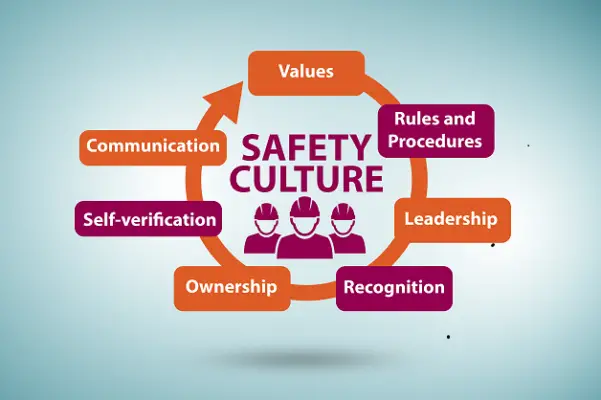Hazard refers to a potential source of harm, commonly found in workplaces. Risks stem from evaluating the likelihood and severity of harm occurring due to hazards present.
Hazards can lead to various negative outcomes such instances as injury, damage, or loss.
Risk assessment involves appraising the probability and consequences of harm systematically, considering factors like exposure frequency and health impacts as potential consequences.
Understanding the disparity between hazard and risk is pivotal to effectively implementing safety measures in a work environment.

Further details await for a deeper insight into the distinctions between hazard and risk.
Key Takeaways
- Hazard refers to a potential source of harm, while risk is the likelihood and severity of harm occurring.
- Hazards are present in workplaces, while risk assessment evaluates the impact of hazards on safety.
- Identifying hazards is crucial for risk assessment, which evaluates consequences and determines control measures.
- Risk assessment involves analyzing factors like exposure frequency and health effects to prioritize control measures.
- Regular risk assessments are necessary for maintaining a safe work environment by addressing hazards and minimizing risks.
Understanding Hazards and Risks
Understanding hazards and risks involves identifying potential sources of harm, evaluating the likelihood of harm occurring, and implementing safety measures to mitigate risks effectively.
Hazard identification methods help recognize various dangers present in the workplace, while risk evaluation techniques assess the severity and probability of harm.
Implementing safety measures based on these evaluations is crucial to creating a safe working environment for employees.
Hazard Identification Methods
Hazard identification methods are essential protocols that involve inspecting equipment and surroundings for potential sources of harm before commencing work.
By actively identifying hazards, organizations can implement control measures to reduce the likelihood of harm and promote health and safety in the workplace.
Regular inspections and involving workers in the hazard identification process are vital steps in risk management to prevent adverse health effects.
Encouraging open communication and reporting of abnormalities during tasks further enhances the effectiveness of hazard identification efforts.
Designing workflows with hazard identification in mind helps create a safer working environment by proactively addressing potential risks. The table below highlights key aspects of hazard identification methods:
| Hazard Identification Methods | Importance |
|---|---|
| Inspecting equipment and surroundings | Critical for safety |
| Encouraging staff to report abnormalities | Enhances risk minimization |
| Conducting regular health and safety inspections | Focuses on hazard identification |
| Involving workers in inspections | Enhances hazard identification processes |
Risk Assessment Techniques
What methods are commonly employed to evaluate risks associated with workplace hazards?
Risk assessment techniques involve appraising the likelihood and severity of harm from hazards in the workplace.
Understanding hazards helps identify potential sources of danger while evaluating risks and determining the level of harm they could cause.
Techniques for risk assessment include analyzing the impact of hazards on different groups and considering exposure duration and frequency.
Effective risk assessment involves scoring the likelihood of harm from hazards to determine the overall risk level.
Proper risk assessment techniques are essential for creating a safe work environment and implementing necessary control measures.
Safety Measures Implementation
Safety measures implementation in the workplace involves thorough identification of potential hazards like toxic substances and forklifts to guarantee the protection of employees and prevent harm.
Risks associated with these hazards can vary from minor injuries to severe consequences, emphasizing the importance of implementing control measures and protective protocols.
Control measures, such as hi-viz gear and physical barriers, significantly reduce risks related to hazards like forklifts.
Effective management procedures, including prioritizing risk assessments and implementing controls, are essential for enhancing workplace safety and minimizing the occurrence of accidents.
By focusing on hazard identification, risk assessment, and applying appropriate protective measures, organizations can create a safer environment for their employees, ultimately reducing workplace accidents.
| Control Measures | Hazardous Situations |
|---|---|
| Hi-viz gear | Forklift operations |
| Physical barriers | Exposure to toxic substances |
| Regular safety training | Working at heights |
| Emergency response plans | Confined spaces |
| Personal protective equipment | Machinery operation |
The difference between hazard and risk
Hazards are potential sources of harm, while risks assess the likelihood of harm occurring.
Distinguishing between hazards and risks is crucial for workplace safety and effective risk management.
It enables organizations to identify, evaluate, and control potential dangers to guarantee a safe working environment.
Definitions of Hazard
In the domain of workplace safety and risk management, distinguishing between hazards and risks is vital for ensuring the well-being of individuals and the smooth operation of organizations.
- A hazard is anything with the potential to cause harm, such as substances, machines, activities, or processes.
- Hazards in almost every workplace and environment must be identified during risk assessment.
- Hazards can lead to death, injury, damage, or loss, underlining their significance in risk management.
Understanding the difference between a hazard, which is a potential source of danger, and a risk, which is the likelihood of that hazard causing harm, is essential.
Identifying hazards is necessary to conduct a free risk assessment and implement appropriate safety measures, regardless of the time of day.
Assessment of Risk
Risk assessment plays a pivotal role in workplace safety by evaluating the likelihood and severity of harm from identified hazards.
It systematically analyzes potential consequences, such as adverse health effects, associated with various hazards.
Through risk analysis, organizations can determine the overall risk posed by different hazards and prioritize control measures to reduce exposure.
Factors like the frequency of exposure, existing controls, and health effects are considered during this process.
Risk assessment aims to effectively manage risks, categorizing them based on their severity, and implementing measures to mitigate them to an acceptable level.
Regular risk assessments are essential for maintaining a safe work environment and ensuring health and safety regulations compliance.
Information About the Nature of Risks and Benefits
Understanding the nature of risks is essential for organizations to prioritize control measures effectively and mitigate potential harm in the workplace.
By conducting risk assessments, companies can identify high, medium, and low-risk categories based on the likelihood and severity of harm posed.
This knowledge allows for implementing safety measures that create safer work environments, reduce accidents, and enhance overall health and safety performance.
Risk Assessment Importance
Efficient risk evaluation is pivotal in safeguarding workplace well-being and operational integrity.
When analyzing risks, it is essential to take into account the likelihood of a hazard causing harm and the potential consequences, such as injury or exposure to harmful chemicals.
By understanding the nature of risks, organizations can better prioritize safety measures and allocate resources effectively.
Effective risk evaluations not only help in identifying workplace hazards but also in determining the level of risk associated with each hazard.
This information is vital for implementing appropriate safety protocols and reducing the harmful effects of potential hazards on employees and the overall work environment.

Safety Measures Implementation
Implementing safety measures is essential for mitigating workplace hazards and promoting a secure work environment conducive to employee well-being and operational efficiency.
Safety measures involve identifying hazards, evaluating risks, and implementing targeted controls to prevent accidents and enhance overall workplace safety.
Understanding the nature of risks allows organizations to prioritize safety interventions effectively.
Companies can tailor safety measures to specific hazards by conducting proper risk evaluations, reducing the likelihood of harm, and creating a safer working environment.
Not only does implementing safety measures protect workers, but it also plays an important role in improving productivity and organizational performance.
Hence, investing in safety protocols and measures is crucial for safeguarding employees and ensuring a successful and sustainable work environment.
Uncertainties in Knowledge About Risks and Benefits
Uncertainties in knowledge about risks and benefits present significant challenges in risk evaluation processes and decision-making.
Considering the complexity of factors involved, incomplete information and varying perspectives can lead to difficulty in accurately evaluating potential hazards and benefits.
Addressing these uncertainties requires thoroughly considering benefit uncertainty and a nuanced approach to risk analysis to guarantee informed decision-making in workplace safety protocols.
Risk Assessment Challenges
In addressing risk assessment challenges, organizations encounter complexities arising from uncertainties surrounding knowledge about risks and benefits.
This uncertainty stems from factors such as the likelihood of exposure to hazardous substances, understanding toxic properties, and the potential impacts on public health and the environment.
Evaluating risks associated with a single exposure can be particularly challenging due to the intricate nature of health and environmental impacts.
Organizations reduce harm from hazards by managing uncertainties and protecting well-being.
It is essential to approach risk assessment with a thorough understanding of these uncertainties to make informed decisions and implement effective risk management strategies.
Benefit Uncertainty Consideration
Managing uncertainties in knowledge about risks and benefits is fundamental to addressing challenges in risk assessment within organizations, particularly when considering benefit uncertainty.
When evaluating benefits that may arise from a particular substance or activity, uncertainties in knowledge can arise due to factors such as incomplete data, differing expert opinions, and cognitive biases.
These uncertainties can affect the assessment of risks associated with the substance or activity, including the likelihood of harm, whether the risks are acute or chronic, and the different methods to measure these risks.
Decision-makers must navigate these uncertainties to make informed choices on how to balance risks and benefits, share the risks appropriately, and implement measures to safeguard the safety of individuals and the environment in which they operate.
Identification of Hazards
Identification of hazards is a critical step in ensuring workplace safety. By recognizing potential dangers through hazard recognition techniques and evaluating risks using various methods, organizations can proactively address safety concerns.
This process is essential for creating a secure work environment and preventing employee accidents or injuries.
Hazard Recognition Techniques
Utilizing effective hazard recognition techniques is vital for ensuring workplace safety and mitigating potential risks to employees and operations.
When identifying hazards, it is essential to take into account a wide range of potential sources of harm. Hazard recognition techniques aid in evaluating the likelihood of harm, whether it be through skin contact, physical hazards, or other means.
Some benefits of such techniques include a proactive approach to prevent accidents, injuries, and occupational illnesses.
To effectively identify hazards, organizations commonly use the following techniques:
- Job safety analysis.
- Workplace inspections.
- Safety audits.
Training employees to recognize hazards and promptly report them is crucial for maintaining a safe work environment and preventing harm from being exposed to individuals.

Risk Assessment Methods
Effective risk assessment methods are crucial in identifying potential hazards within the workplace environment.
To assess risks accurately, organizations must take a detailed look at the likelihood of harm from various sources, such as substances or environmental conditions.
Risk assessment methods can pinpoint areas of concern by examining access levels to certain hazards and considering different circumstances, including the presence of children.
Prioritizing hazards based on their potential to cause harm allows for focused mitigation strategies.
Understanding the levels of risk associated with each hazard enables companies to implement appropriate safety measures to protect employees and maintain a secure work environment.
Regular evaluations and employee involvement in hazard identification are essential to an effective risk assessment process.
Estimation of Exposure
Estimating exposure to hazards involves evaluating the level and duration of contact individuals have with potential sources of harm in the workplace.
This assessment considers various factors like the frequency and concentration of exposure and the routes through which exposure can occur, such as inhalation, ingestion, or skin contact.
Accurately estimating exposure is vital for conducting thorough risk assessments and implementing effective control measures to safeguard the safety and well-being of employees.
Exposure Assessment Methods
Exposure assessment methods play an essential role in determining the level and duration of contact individuals have with hazards in the workplace. Methods for estimating exposure include:
- Monitoring air quality to measure the concentration of hazards in the environment.
- Conducting personal sampling to assess individual exposure levels.
- Using exposure models to predict potential exposure scenarios based on various factors.
These methods help understand the likelihood of exposure to one substance or a combination of hazards at different levels.
Exposure assessment helps identify potential risks based on factors like frequency and duration of exposure, particularly in vulnerable populations such as the elderly.
It is essential to evaluate the danger posed by hazards and answer the following questions for effective risk management strategies.
Risk Evaluation Techniques
Quantifying the level and duration of exposure to hazards is fundamental to evaluating risks in occupational settings.
Exposure estimation techniques involve measuring the amount and duration of exposure to a hazard, aiding in determining potential health effects and establishing control measures. Below is a table illustrating different scenarios of exposure evaluation:
| Exposure Scenario | A short period of exposure | Other Hazards Present | Duration of Exposure | Example |
|---|---|---|---|---|
| Long periods of exposure | High | Yes | Extended | Continuous operation in a chemical plant |
| Short period of exposure | Low | No | Brief | Spill clean-up by a trained individual |
Accurate estimation of exposure is crucial for evaluating risks and implementing effective risk management strategies.

Estimation of the Probability of Harm
How can we accurately gauge the likelihood of harm resulting from workplace hazards? Estimating the probability of harm is a critical aspect of risk assessment in ensuring workplace safety.
To achieve this, consider the following:
- Analyzing the frequency of exposure to a hazard.
- Evaluating the duration of exposure to the hazard.
- Appraising the vulnerability of individuals to potential harm.
Choices of Numerical Measures for Risk
In the context of workplace safety and risk assessment, a key consideration involves selecting appropriate numerical measures to quantify potential harms and prioritize risks effectively.
Numerical measures for risk encompass probabilities, frequencies, rates, and severity levels. Risk assessment tools utilize numerical values to gauge the likelihood and impact of potential harm, aiding in prioritizing risks based on these values.
Common quantitative risk measures include risk scores, risk ratings, and risk matrices, offering visual aids for analysis.
Understanding these numerical measures aids in making informed decisions and allocating resources efficiently.
Frequently Asked Questions
What Is the Main Difference Between Risk and Hazard?
Understanding the distinction between hazards and risks is essential for workplace safety.
It enables effective assessment and management of potential dangers, allowing organizations to implement appropriate safety measures and protocols to guarantee a safe working environment for employees and operations.
What Is a Risk Example?
A risk example involves driving in heavy rain, where reduced visibility and slippery roads pose hazards.
Understanding and managing risks is essential for workplace safety, enabling organizations to implement safety measures that protect employees and operations.
How Do You Identify Hazards and Risks?
Identifying hazards and risks in the workplace involves conducting thorough assessments to pinpoint potential sources of harm and evaluating the likelihood of these hazards causing harm.
This process is essential for effective risk management and ensuring employee safety.
What Is a Hazard or Risk in the Workplace?
A hazard in the workplace is any potential source of danger or harm, such as chemicals or machinery.
Risk refers to the likelihood of a hazard causing harm, considering factors like frequency of exposure. Identifying and managing hazards and risks are essential for workplace safety.

Conclusion
To summarize, the distinction between hazards and risks is vital in promoting workplace safety.
Organizations can create a safe workplace by identifying threats, evaluating their likelihood, and implementing tailored safety measures.
Managing risks through proactive hazard identification and risk evaluation reduces potential harm and enhances business operations.
Understanding and effectively addressing hazards and risks enable organizations to prioritize safety and resilience in their daily operations.

Chris Ekai is a Risk Management expert with over 10 years of experience in the field. He has a Master’s(MSc) degree in Risk Management from University of Portsmouth and is a CPA and Finance professional. He currently works as a Content Manager at Risk Publishing, writing about Enterprise Risk Management, Business Continuity Management and Project Management.

